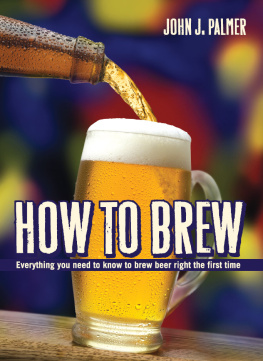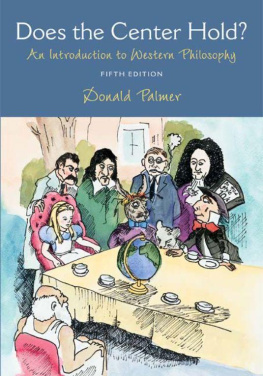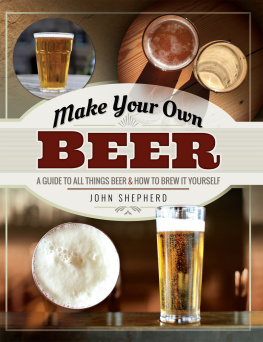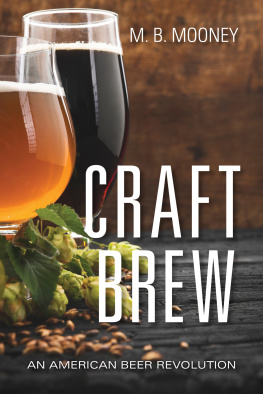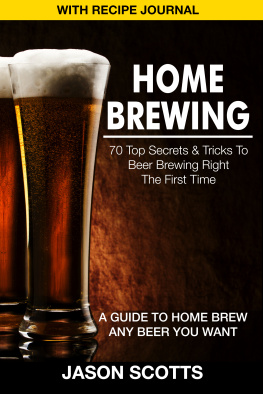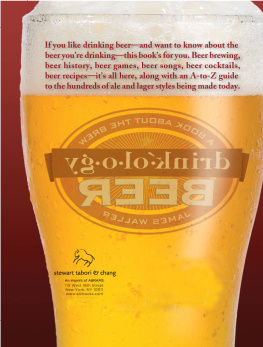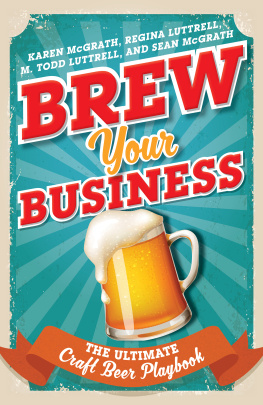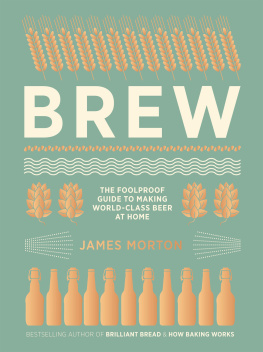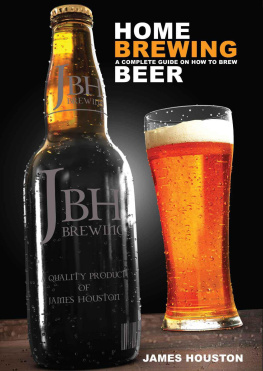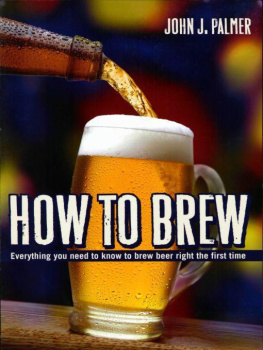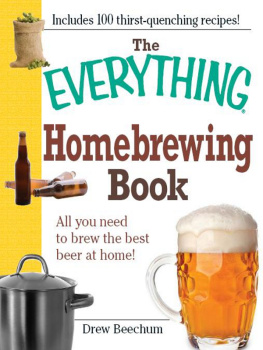ACKNOWLEDGEMENTS
This book is dedicated to all my brewing friends all over the world. I couldnt have done it without your enthusiasm and support.
I am constantly overwhelmed by the generosity of brewers in sharing information, their time, and their passion for beer and brewing. There are so many people I need to thank for making this third edition possible.
My wife, for raising an eyebrow and saying, Well? (Get going!)
My friends in the Crown of the Valley Brewing Club: Tim Aberle, Herb Adams, Michael Babcock, JT Blancett, Brian Dearden, Jeff Crowell, Bob Curtiss, Brian Dellosa, Bob Gunner, Erik Kobulnick, Dale Lauterbach, Shawn Olsson, Doug Parker, Mike Peterson, Todd Peterson, James Reynolds, Andrew Sayeg, Jamie Smith, Robert Streutker, Paul Valvidiez, Scott Velasquez, Vitol Wiacek, for friendship, project support, and good beers.
There are several people that I would pester with phone calls and late night emails to answer tough questions, and they had a real hand in helping me develop this book:
A.J. deLange
Steve Alexander
Bob Hansen of Briess Malt & Ingredients Company
Brian Kern
Berne Jones, Ph.D, of the U.S. Department of Agriculture
Evan Evans, Ph.D, of the Tasmanian Institute of Agricultural Research
Greg Doss of Wyeast Laboratories Inc.
Chris White of White Labs Inc.
Mark Jilg and Todd Peterson of Craftsmen Brewery
Matt Brynildson of Firestone Walker Brewery
And I want to thank Ray Daniels and Randy Mosher for enthusiastically getting behind the third edition and asking the tough questions that made it better.
John
October 5, 2005
Notes on the Third Edition
How to Brew Your First Beer was created in 1993 as a twelve-page electronic document that contained everything that a beginning brewer would need to know to get started. It contained equipment descriptions, process descriptions, and some of the whys of homebrewing. I posted it to electronic bulletin boards and homebrewing ftp sites such as sierra.stanford.edu. (Would you believe that the World Wide Web didnt exist back then?) It was written to help the first-time brewer produce a foolproof beerone he or she could be proud of. That document apparently served quite well; it was requested and distributed to every continent (including Antarctica) and translated into Spanish, Italian, Czech, Korean, and Japanese. Glad I could help.
As time went by, I received requests from brewers to write how-tos for the more complex brewing methods, such as extract-and-specialty-grain and all-grain brewing. There is a lot to talk about with these methods, though, and I realized that it would be best done with a book. After years and years of writing and rewriting, I published the first edition of How to Brew online with the help of the Real Beer Page in June 2000. But I immediately started receiving requests for hard copy. Of course, in the process of laying it out, I couldnt resist the chance to improve it. The second edition was self-published in 2001. It added different sparging techniques and a more technical discussion of fluid flow in the lauter tun, as well as more pictures and data tables than the online edition.
Since that time, there have been a couple of changes in the state-of-the-art of homebrewing:
- The brewing quality of malt extract has been improving for more than a decade and is, in fact, excellent, but the basic extract brewing methods have gone unchanged since we brewed with bakers extract.
- Batch sparing and no-sparge methods for all-grain brewing are now as popular as the continuous-sparging method, which used to be the only method discussed in the literature.
To give these changes their due, I had to rework most of the chapters of the book. Sometimes it was just a sentence or two, other times it was the entire presentation of the chapter.
This was also an opportunity to improve on topics I had only touched on before:
- Brewing sugars other than maltose
- Beer clarity and controlling beer haze
- Beer color and how to estimate it in a recipe
- Acid calculations for controlling mash and sparge pH.
I also re-took a few pictures.
Cheers!
John

TABLE OF CONTENTES
Discretion Is the Better Part of Flavor - 246
Continuous Sparging Procedure - 306
Brewers Publications
A Division of the Brewers Association
PO Box 1679, Boulder, Colorado 80306-1679
BrewersAssociation.org
2006 by John J. Palmer
All rights reserved. No portion of this book may be reproduced in any
form without written permission of the publisher. Neither the author,
editor nor the publisher assume any responsibility for the use or
misuse of information contained in this book.
Printed in the United States of America.
10 9 8 7
ISBN-13: 978-0-937381-88-5
ISBN-10: 0-937381-88-8
Library of Congress Cataloging-in-Publication Data
Palmer, John J., 1963
How to brew : ingredients, methods, recipes and equipment
for brewing beer at home / by John J. Palmer.-- 3rd ed.
p. cm.
Includes bibliographical references and index.
ISBN-13: 978-0-937381-88-5
1. Brewing--Amateur's manuals. I. Title.
TP570.P275 2006
641.8'73--dc22
2006004807
Publisher: Ray Daniels
Technical Editor: Randy Mosher
Copy Editor: Daria Labinsky
Index: Daria Labinsky
Production & Design Management: Stephanie Johnson
Cover and Interior Design: Julie Lawrason
Cover photo: Souders Studios/Square Pixels
Interior photos: Naomi K. Palmer and John Palmer

INDEX
Entries listed in boldface refer to illustrations or captions.
abbey ale,
acetaldehyde. See off-flavors
adjuncts, See also Free Amino Nitrogen, malt, mash and mashing, sugars
cereal mashing procedure,
and diastatic power of malt,
roasted barley,
Some Typical Color Ratings of Common Malts and Adjuncts (table),
Starch Gelatinization Temperatures (table), 144
aeration,
airlock. See equipment
alcohol by volume. See also gravity estimating,
Percent Alcohol By Volume (ABV) From OG and FG (table),
ales,
and length of primary fermentation phase,
and secondary conditioning,
and cold conditioning,
and yeast,
Recommended Pitching Rates for Ale Yeast Strains As a
Function of Wort Gravity (table),
all-grain brewing. See mash and mashing
alpha acid unit (AAU), . See also hops, International Bittering Unit
calculating,
altbier, . See also ales
amber ale,
Joe Ale (recipe),
American lager, . See also lagers
Typical American Lager Beer (recipe),
American pale ale,
Cincinnati Pale Ale (recipe)
Lady Liberty Ale (recipe),
American wheat beer,
attenuation. See yeast
autolysis. See off-flavors
bacteria. See gushing, haze, off-flavors
barley. See adjuncts, malt
barley wine,
beer kits,
beerstone removal. See cleaning
Belgian-style ales. See individual styles
Belgian-style strong ale,
Berliner weisse, . See also wheat beer
bitter, . See also British-style ale

